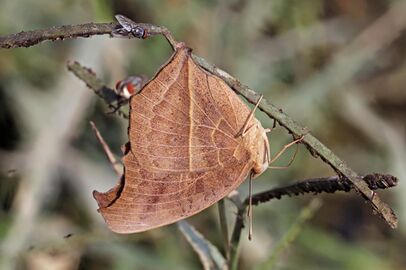Biology:Junonia almana
| Peacock pansy | |
|---|---|

| |
| Scientific classification | |
| Domain: | Eukaryota |
| Kingdom: | Animalia |
| Phylum: | Arthropoda |
| Class: | Insecta |
| Order: | Lepidoptera |
| Family: | Nymphalidae |
| Genus: | Junonia |
| Species: | J. almana
|
| Binomial name | |
| Junonia almana (Linnaeus, 1758)
| |
| Synonyms[1] | |
| |
Junonia almana, the peacock pansy,[2][3] is a species of nymphalid butterfly found in Cambodia and South Asia.[2][3] It exists in two distinct adult forms, which differ chiefly in the patterns on the underside of the wings; the dry-season form has few markings, while the wet-season form has additional eyespots and lines. It is listed as Least Concern in the IUCN Red List.[4]
Description
The adult butterfly has a wingspan of 54–62 mm (2.1–2.4 in),[1] and exhibits seasonal polyphenism.
Dry-season form
"Upperside rich orange-yellow. Fore wing with a pale dusky and a much darker short transverse bar with lateral jet-black marginal lines across cell, another somewhat similar bar defining the discocellulars; costal margin, an inner and an outer subterminal line, and a terminal line dusky black; a large minutely white-centred ocellus with an inner slender and outer black ring on disc in interspace 2; two similar but smaller geminate subapical ocelli with an obscure pale spot above them and a short oblique bar connecting them to the black on the costa. Hind wing: a small minutely white-centred and very slenderly black-ringed discal ocellus in interspace 2, with a very much larger pale yellow and black-ringed ocellus above it spreading over interspaces 4, 5 and 6, the centre of this ocellus inwardly brownish orange, outwardly bluish black, with two minute white spots in vertical order between the two colours; finally postdiscal subterminal and terminal black sinuous lines.[1]
"Underside ochraceous brown, very variable. In most specimens the cell of the fore wing is crossed by three dark sinuous bands, the outermost along the discocellulars; these are very faint in some; both fore and hind wings crossed by a basal and a discal pale sinuous line, the latter margined outwardly by a dark shade, which is traversed by an obscure somewhat obsolescent row of dark spots, and outwardly bounded by a subterminal sinuous line, the dark shade in many cases spreading on the fore wing to the terminal edge of the wing; on the hind wing the subterminal line meets the discal in an acute angle at the tornus. Antennae dark brown; head, thorax and abdomen more or less orange-brown; paler beneath."[1][5]
Wet-season form
"Upperside similar, the black markings deeper in colour and heavier, the subterminal and terminal lines more clearly defined.
"Underside pale ochraceous. Fore wing: cell crossed by live short sinuous dark brown lines, a similar line on the discocellulars and another beyond it, both bent inwards at an angle and continued to the dorsum, the space between them forming a discal broad fascia, which pales to whitish posteriorly; the postdiscal ocelli, subterminal and terminal lines as on the upperside but paler. Hind wing: a slender transverse subbasal dark line, a discal whitish straight fascia in continuation of the one on the fore wing; the postdiscal ocelli, the subterminal and terminal lines much as on the upperside but paler; the anterior ocellus with a double iris and centre. Antennae dark brown; head, thorax and abdomen slightly darker than in the dry-season form."[1]
Distribution
J. almana is found in India , Sri Lanka and South East Asia, and eastwards to China and Japan .[1][2][3]
Larva
The caterpillars of Junonia almana feed on a variety of plants, including Hygrophila auriculata, Phyla nodiflora and species in the genera Acanthus, Barleria and Gloxinia.[6]
"Cylindrical. Head blackish, slightly hairy. Body pale ochreous-brown, with a dorsal, subdorsal and lateral blackish line, and a row of small-ringed spots below the latter; second segment anteriorly with a transverse reddish stripe; second, third and fourth segments posteriorly with a transverse blackish stripe; second to last segment armed with a dorsal, subdorsal, and two lateral rows of short, fine-branched spines." (Frederic Moore quoted by C. T. Bingham)[1]
Pupa
"Rather short and thick; head and thorax broad, headpiece pointed beneath; thorax and abdomen dorsally with short tubercular points; colour brownish-ochraceous." (Frederic Moore quoted by C. T. Bingham)[1]
References
- ↑ 1.0 1.1 1.2 1.3 1.4 1.5 1.6 1.7
 This article incorporates text from a publication now in the public domain: Bingham, Charles Thomas (1905). Fauna of British India. Butterflies Vol. 1. pp. 361–362. https://archive.org/stream/butterfliesvolii00bing#page/360/mode/2up/.
This article incorporates text from a publication now in the public domain: Bingham, Charles Thomas (1905). Fauna of British India. Butterflies Vol. 1. pp. 361–362. https://archive.org/stream/butterfliesvolii00bing#page/360/mode/2up/.
- ↑ 2.0 2.1 2.2 Varshney, R.K.; Smetacek, Peter (2015). A Synoptic Catalogue of the Butterflies of India. New Delhi: Butterfly Research Centre, Bhimtal & Indinov Publishing, New Delhi. pp. 219. doi:10.13140/RG.2.1.3966.2164. ISBN 978-81-929826-4-9.
- ↑ 3.0 3.1 3.2 Savela, Markku. "Junonia almana (Linnaeus, 1758)". http://www.nic.funet.fi/pub/sci/bio/life/insecta/lepidoptera/ditrysia/papilionoidea/nymphalidae/nymphalinae/junonia/#almana.
- ↑ "Peacock Pansy". https://www.iucnredlist.org/species/160318/5362204.
- ↑
 This article incorporates text from a publication now in the public domain: Moore, Frederic (1899–1900). Lepidoptera Indica. Vol. IV. London: Lovell Reeve and Co.. pp. 78–82. https://www.biodiversitylibrary.org/item/103628#page/90/mode/1up.
This article incorporates text from a publication now in the public domain: Moore, Frederic (1899–1900). Lepidoptera Indica. Vol. IV. London: Lovell Reeve and Co.. pp. 78–82. https://www.biodiversitylibrary.org/item/103628#page/90/mode/1up.
- ↑ Krushnamegh Kunte & Madhav Gadgil (2000). "Appendix I. Larval host plants of peninsular Indian butterflies". Butterflies of Peninsular India. Universities Press. pp. 221–228. ISBN 978-81-7371-354-5. https://books.google.com/books?id=cuPPjOMcu_4C&pg=PA224.
External links
Wikidata ☰ Q986190 entry
 |





